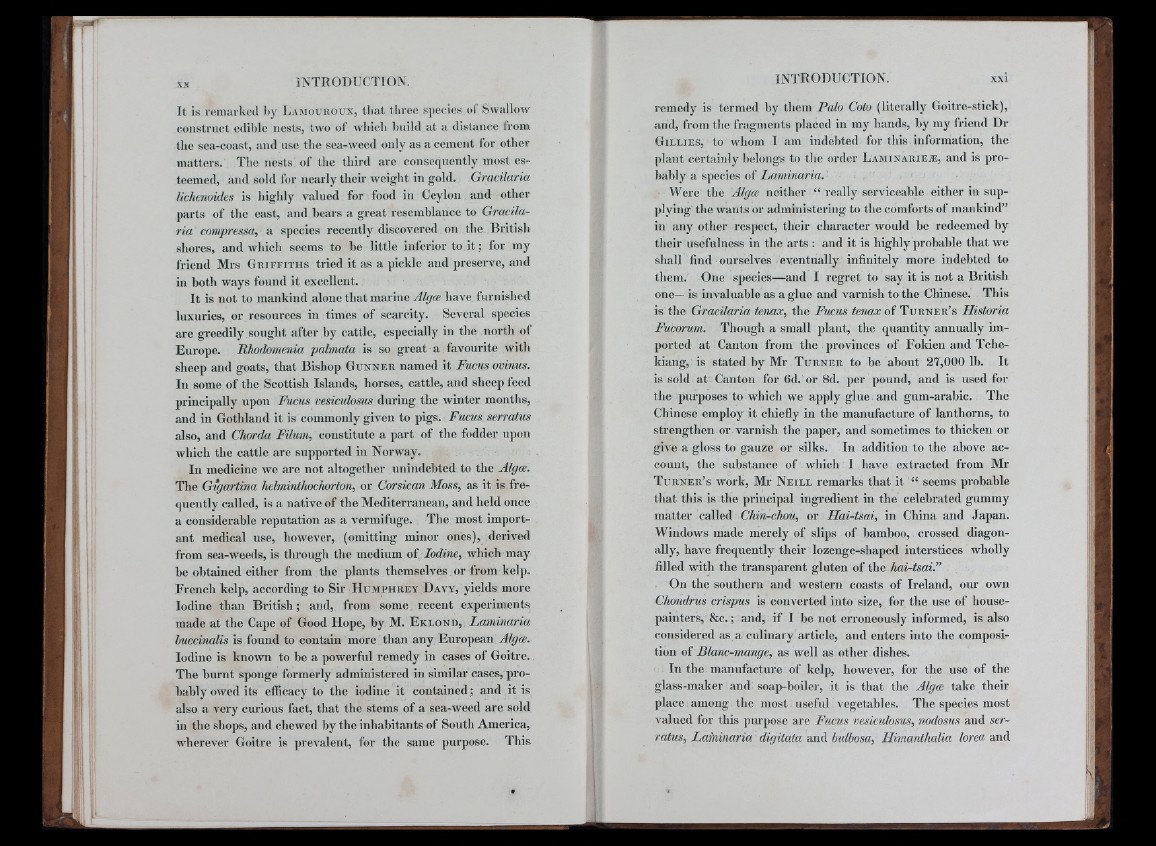
I t is remarked by li.u io u R O U X , tliat three species of Sivalloxv
construct edible nests, two of which build at a distance from
the sea-coast, and use the sea-wccd only as a cement for other
matters. The iiests of the third arc coiisequcutly most esteemed,
and sold for nearly tlieir weight in gold. Gracilaria
lichenoides is highly valued for food in Ceylon and other
parts of the east, and hears a great rescmhlanee to Gracilaria
compressa, a species recently discovered on the British
shores, and which seems to he little inferior to i t : for my
friend Mrs G r i f f i t h s tried it as a pickle and preserve, and
in both ways found it excellent.
I t is not to mankind alone th a t marine Algw have furnished
luxuries, or resources in times of scarcity. Several species
are greedily sought after by cattle, especially iu the north of
Europe. Rhodomenia pahnata is so great a favourite with
sheep and goats, that Bishop G u n n e r named it Fucus ovinus.
Ill some of the Scottish Islands, horses, cattle, and sheep feed
principally upon Fucus vesicidosus during the winter months,
and in Gothland it is commonly given to pigs. Fucus serratus
also, and Chorda Filum, constitute a part of the fodder upon
which the cattle are supported in Norway.
In medicine we are not altogether unindebted to the Alga.
The Gigartina helminthockorton, or Corsican Moss, as it is frequently
called, is a native of the Mediterranean, and held once
a considerable reputation as a vermifuge. The most important
medical use, however, (omitting minor ones), derived
from sea-weeds, is through the medium of Iodine, which may
he obtained either from the plants themselves or from kelp.
French kelp, according to Sir H u m p h r e y D a v y , yields more
Iodine than B ritish ; and, from some recent experiments
made at the Cape of Good Hope, hy M. E k l o n d , Famirmria
Imccinalis is found to contain more than any European Algce.
Iodine is known to be a powerful remedy in cases of Goitre.
The burnt sponge formerly administered in similar cases, probably
owed its efficacy to the iodine it contained; and it is
also a very curious fact, th a t the stems of a sea-weed are sold
iu the shops, and chewed hy the inhabitants of South America,
wherever Goitre is prevalent, for the same purpose. This
remedy is termed hy them Falo Coto (literally Goitrc-stick),
and, I'rom the fragments placed in my hands, by my friend Dr
G i l l i e s , to whom I am indebted for this information, the
plant certainly belongs to tlie order L a m in a r ie æ , and is probably
a species of Laminaria.
Were the Algce neither “ really serviceable either in sup-
jilying the wants or administering to the comforts of mankind”
in any other resjject, their character would he redeemed hy
their usefulness in the arts : and it is highly probable that we
shall find ourselves eventually infinitely more indebted to
them. One species—and I regret to say it is not a British
one— is invaluable as a glue and varnish to the Chinese. This
is the Gracilaria tenax, the Fucus tenax of T u r n e r ’ s Historia
Fucorum. Though a small plant, the quantity annually imported
at Canton from the provinces of Fokien and Tche-
kiang, is stated hy Mr T u r n e r to he about 27,000 Ih. It
is sold at Canton for 6d. or 8d. per pound, and is used for
the purposes to which we apply glue and gum-arabic. The
Chinese employ it chiefly in the manufacture of lanthorns, to
strengthen or varnish the paper, and sometimes to thicken or
give a gloss to gauze or silks. In addition to the above account,
the substance of which I have extracted from Mr
T u r n e r ’ s work, Mr N e i l l remarks th a t it “ seems probable
that this is the principal ingredient in the celebrated gummy
matter called Chin-chou, or Hai-tsai, in China and Japan.
Windows made merely of slips of bamboo, crossed diagonally,
have frequently their lozenge-shaped interstices wholly
filled with the transparent gluten of the hai-tsai.”
On the southern and western coasts of Ireland, our own
Chondrus crispus is converted into size, for the use of house-
painters, &c. ; and, if I be not erroneously informed, is also
considered as a culinary article, and enters into the composition
of Blanc-mange, as well as other dishes.
In the manufacture of kelp, howevei", for the use of the
glass-maker and soap-boiler, it is that the Algce take their
place among the most useful vegetables. The species most
valued for this purpose arc Fucus vesiculosus, nodosus and serratus,
Lafninaria digitata and bulhosa, Ilimanthalia lorea and